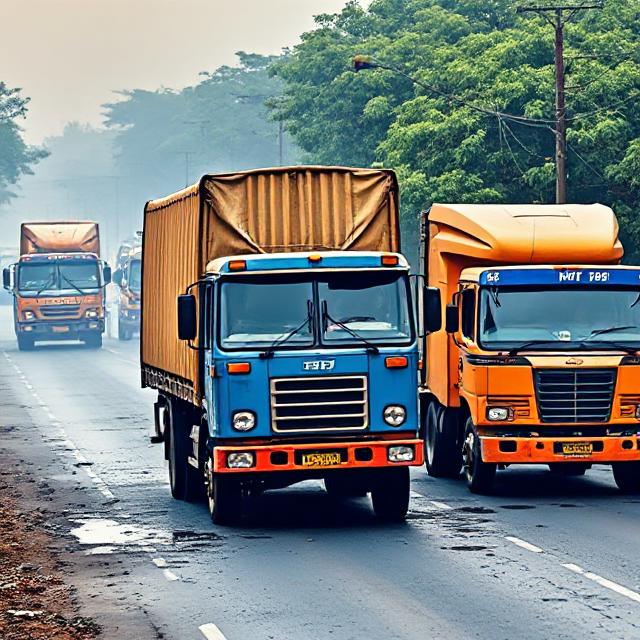India’s trucking industry is facing a crisis. From driver shortages to poor infrastructure, explore the 7 major issues that are disrupting freight movement and logistics efficiency across the country.
India’s Trucking Crisis: 7 Major Issues Impacting the Industry
India’s trucking industry is a vital link in the country’s logistics and supply chain, moving more than 60% of all freight across the nation. Despite its importance, the sector is in a state of crisis, grappling with long-standing and worsening challenges that threaten the efficiency, safety, and profitability of freight movement.
Let’s explore the 7 major issues currently affecting the Indian trucking industry — and why solving them is critical to the nation’s economic growth.
1. 🛣️ Poor Road Infrastructure
India’s massive road network hides a serious flaw — a large portion is still unpaved or poorly maintained.
- Potholes, traffic jams, and narrow highways reduce driving speeds
- Overloaded routes lead to faster vehicle wear and fuel waste
- Limited expressways and delays at bottlenecks like toll booths
Result: Delayed deliveries, increased costs, and frequent breakdowns.
2. 👨✈️ Truck Driver Shortage
India faces a severe shortage of skilled and willing truck drivers. For every 1,000 trucks, there are only around 700 licensed drivers.
- Long hours with poor living conditions
- Low wages, limited job respect, and no benefits
- Lack of clean rest stops and roadside amenities
Result: Idle fleets, delayed shipments, and increased driver attrition.
3. ⛽ High Fuel Prices and Maintenance Costs
Fuel accounts for more than 50% of truck operating costs, and diesel price volatility severely impacts margins.
- Limited adoption of alternative fuels like CNG or electric trucks
- Expensive vehicle parts and frequent repairs due to poor roads
- Maintenance delays because of lack of authorized service centers
Result: Shrinking profitability and higher freight rates for customers.
4. 📄 Complex Regulatory Environment
India’s trucking ecosystem is tangled in red tape and overlapping regulations.
- Frequent checks, permits, tolls, and taxes across states
- Corruption at checkpoints and delays due to paperwork
- Sudden policy changes without clear ground-level communication
Result: Wasted man-hours and reduced operational efficiency.
5. 🚛 Unorganized and Fragmented Sector
Most of India’s trucks are owned by small, unorganized fleet operators.
- Lack of digital tools or logistics management systems
- No standard pricing models or quality assurance
- Poor ability to compete with large, tech-enabled logistics firms
Result: Inefficiency, inconsistent services, and low scalability.
6. 🏗️ Lack of Supporting Logistics Infrastructure
Beyond roads, the absence of logistics parks, warehouses, and driver amenities adds to the crisis.
- Few truck terminals with loading docks, parking, or security
- Lack of cold chain facilities and specialized cargo hubs
- No nationwide network of rest areas or refueling infrastructure
Result: Cargo damage, driver fatigue, and inefficient routes.
7. 💻 Low Tech Penetration
Digital transformation is still limited to large fleet owners. Most smaller operators still work manually.
- Paper-based records, manual dispatching, no real-time tracking
- Low use of route optimization, fuel management, or telematics
- Limited training on new logistics or safety technology
Result: Missed opportunities for cost savings and productivity gains.
🚛 Why This Crisis Matters
The trucking industry touches every part of India’s economy — from agriculture and manufacturing to retail and e-commerce. If these issues persist, the consequences will be felt across delivery timelines, product costs, and business operations.
🔧 What’s Needed?
To turn this crisis around, India needs to:
- Modernize road and logistics infrastructure
- Provide better working conditions and incentives for drivers
- Support digital adoption among small fleet owners
- Encourage cleaner, cost-effective fuel alternatives
- Streamline regulatory processes and inter-state transport
🛤 Final Thoughts
India’s trucking industry isn’t just facing operational problems — it’s confronting a full-blown crisis. The good news? With the right policy support, private investment, and innovation, the sector can bounce back stronger and smarter.
A modern, reliable trucking ecosystem isn’t a luxury — it’s a national necessity.

